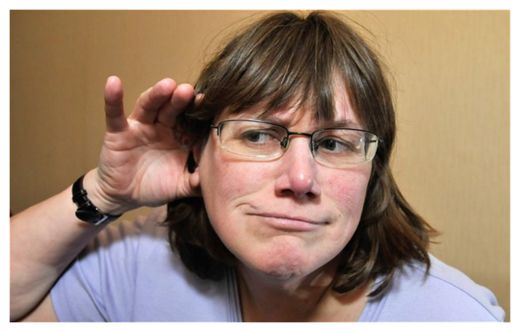
Julie Redfern from Padiham, Lancashire has developed supersonic hearing following a bike accident.
The receptionist, of Padiham, Lancashire, had to stop dining with friends because she could not hear them speak over the sound of her own chewing.
Mrs Redfern, 47, also had to cut out crunchy foods like apples and crisps because of the loud noises they made.
She struggled at work because the phone ringing on her desk would make her eyeballs shake loudly from the vibrations, but her condition is being cured with pioneer surgery.
Mrs Redfern first noticed the condition aged 40 as she sat playing the computer game, Tetris, and realised she could hear her eyes squeak as they moved from side to side.
She said: "I was playing on the game and I thought 'What's that noise?' Then I realised that it was my eyeballs.
"Every time the block moved and I followed it with my eyes I could hear them squeaking. It was a horrible sensation, I could literally hear them moving, scratching, it was very weird."
Her doctors told her it may be her age, but Mrs Redfern found an article about a man who had the same symptoms as her and was referred to Manchester Royal Infirmary.
She was found to suffer from superior canal dehiscence syndrome (SCDS), a rare medical condition of the inner ear caused by a thinning or honeycombing of a bone in the ear, which causes over-sensitivity to sound.
She told the newspaper: "I thought I can't put up with this forever, I knew something wasn't right. I could hear things that were louder than they should have been, I could hear myself swallowing and my voice echoing."
Dr Gerald Brookes, a consultant neuro-otologist and skull base surgeon at the The Harley Street ENT Clinic in London, explained some people could be born with a missing bone in the inner ear, or have a thin one which dissolves with age.
It was only recognised in 1998, and the number of SCDS sufferers is unknown as it can be misdiagnosed as tinnitus or other hearing disorders.
Mrs Redfern said fluid was leaking from the superior canal in her ear and turning the bone into a honeycomb that amplified sounds in her body.
She had a complex five-hour operation to fill in the holes on the bones to stop the sound travelling through them.
The operation held risks of deafness, but Mrs Redfern had one ear operated on successfully and is now aiming to have the same surgery on her other ear.
She added: "Even though there were risks I had to have it done, I couldn't have coped with it for another forty years, seven was enough."



Reader Comments
to our Newsletter